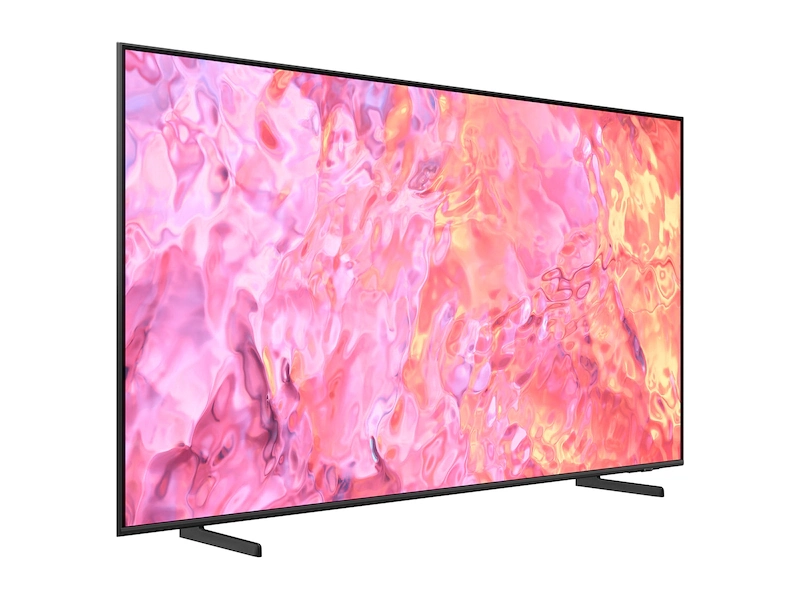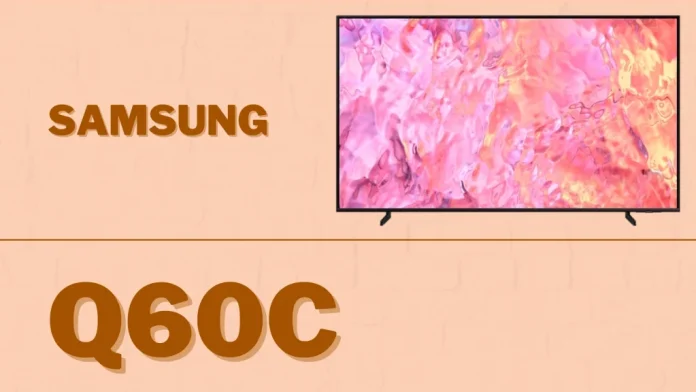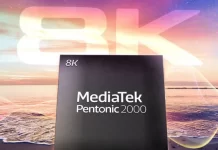The Samsung Q60C is one of the more budget-friendly models in Samsung’s QLED lineup, this one is slightly better than the Crystal but certainly not a QLED, which prompted me to do a full review on the 75-inch version.
Samsung Q60C: detailed specifications and essential features
The Samsung Q60C, released in 2023, features a VA panel made with QLED technology. The refresh rate is standard – 60 Hz, but in the 85-inch version it is increased to 120 Hz. The fact is that Samsung no longer produces LED panels, but buys from third-party manufacturers, so for 85-inch TVs were purchased panels with a frequency of 120 Hz.
Below is a table with the main technical specifications, as well as a more detailed description of each function of the TV.
| Category | Specification |
|---|---|
| Product | Q60C |
| Type | QLED |
| Series | 6 |
| Design | AirSlim |
| Color | TITAN GRAY |
| Stand Type | NEW SIMPLE STAND |
| Bezel Type | 3 Bezel-less |
| Slim Type | Slim look |
| Front Color | TITAN GRAY |
| Screen Size | 74.5″ |
| Resolution | 3,840 x 2,160 |
| Refresh Rate | 60Hz |
| Screen Size | 75″ |
| Resolution | 3,840 x 2,160 |
| Color | 100% Color Volume |
| HDR (High Dynamic Range) | Quantum HDR |
| Picture Processor | Quantum Processor Lite 4K |
| Film Mode | Yes |
| HLG (Hybrid Log Gamma) | Yes |
| Contrast | Dual LED |
| Ultimate UHD Dimming | Supreme UHD Dimming |
| Contrast Enhancer | Yes |
| HDR10+ | Yes (ADAPTIVE) |
| Picture Engine | Quantum Processor Lite 4K |
| Motion Technology | Motion Xcelerator |
| One Billion Color | Yes |
| Picture Clarity | Yes |
| Smart Calibration | Basic |
| Filmmaker Mode | Yes |
| Brightness/Color Detection | Brightness Detection |
| Audio | |
| Dolby | MS12 2ch |
| Sound Output (RMS) | 20W |
| Speaker Type | 2CH |
| Multiroom Link | Yes |
| OTS Lite | Yes |
| Q-Symphony | Yes |
| Bluetooth Headset Support | Yes |
| Bluetooth Audio | Yes |
| Dual Audio support (Bluetooth) | Yes |
| Object Tracking Sound | OTS Lite |
| Adaptive Sound | Adaptive Sound |
| Buds Auto switch | Yes |
| Eco Sensor | Yes |
| SmartThings | Yes |
| Caption (Subtitle) | Yes |
| Embedded POP | Yes |
| EPG | Yes |
| IP Control | Yes |
| OSD Language | English, Spanish, French |
| V-Chip | Yes |
| MBR Support | Yes |
| ConnectShare™ | Yes |
| Inputs & Outputs | |
| HDMI Connections | 3 |
| USB | 2 |
| Ethernet (LAN) | 1 |
| Terrestrial / RF Input | 1/1 (Common Use for Terrestrial) / 0 |
| Digital Audio Out (Optical) | 1 |
| Dimensions | |
| Product Size (W x H x D) Without Stand | 66″ x 37.8″ x 1″ |
| Product Size (W x H x D) With Stand | 66″ x 39.3″ x 12.6″ |
| Stand Size (WxHxD) | 1.6″ x 9.2″ x 12.6″ |
| Distance Between Stand Legs | 49.6″ |
| Shipping Size (W x H x D) | 72.2″ x 43.7″ x 7.5″ |
| Power | |
| Power Supply (V) | AC110-120V~ 50/60Hz |
| Typical Power Consumption | 79W |
| Maximum Power Consumption | 220W |
| Standby Power Consumption | 0.5W |
| System | |
| DTV Tuner | ATSC/ClearQAM |
| Analog Tuner | Yes |
| Operating System | Tizen™ Smart TV |
| DTV Sound System | Dolby |
| VESA Wall Mount Compatibility | Yes |
| Accessory | |
| Remote | TM2360E |
| Power Cable | Yes |
| User Manual | Yes |
| E-Manual | Yes |
| Remote Controller Model | TM2360E |
| Remote Controller Model Code | BN59-01432A |
| VESA Wall Mount Support | Yes |
| Slim Fit Wall-mount Support | Yes |
| Zigbee / Thread Module | Built-in |
| Full Motion Slim Wall Mount Support | Yes |
| SlimFit Cam Support | Yes |
| Eco Sensor | Yes |
| Auto Power Saving | Yes |
| Auto Power Off | Yes |
| Smart Service | |
| Bixby | US English, UK English, India English, Korean, French, German, Italian, Spanish, BR Portuguese (features vary by language) |
| Built-in Voice Assistant | Alexa |
| Works With AI Speaker | Alexa, Google Assistant |
| TV Plus | Yes |
| Web Browser | Yes |
| SmartThings Hub / Matter Hub / IoT-Sensor Functionality | Yes |
| Samsung Health | Yes |
| Universal Guide | Yes (US only) |
| Media Home | Yes |
| Smart Features | |
| Multi Device Experience | Mobile to TV, TV initiate mirroring, TV Sound to Mobile, Sound Mirroring, Wireless TV On |
| Tap View | Yes |
| Multi View | Up to 2 videos |
| Music Wall | Yes |
| Mobile Camera Support | Yes |
| Easy Setup | Yes |
| App Casting | Yes |
| Ambient Mode | Ambient Mode |
| Workspace | Yes |
| Wireless Dex | Yes |
| Web Service | Microsoft 365 |
| Chat Together | Yes (US only) |
| NFT | Nifty Gateway, La Collection, Art Token, Savage |
| ConnecTime | Yes (US only) |
| Telemedicine | HealthTap (US Only) |
| Game Feature | |
| Auto Game Mode (ALLM) | Yes |
| Game Motion Plus | Yes |
| Super Ultra Wide Game View | Yes |
| Game Bar 3.0 | Yes |
| Mini Map Zoom | Yes |
| Light-Sync | Yes |
| HGiG | Yes |
| Gaming Hub | Yes (KR, US, CA, BR, GB, FR, DE, IT, ES) |
| Connectivity | |
| HDMI | 3 |
| HDMI Audio Return Channel | Yes |
| Anynet (HDMI-CEC) | Yes |
| USB | 2 |
| Ethernet (LAN) | 1 |
| Digital Audio Out (Optical) | 1 |
| RF In (Terrestrial / Cable Input / Satellite Input) | 1/1(Common Use for Terrestrial) / 0 |
| Ex-Link (RS-232C) | w/ Dongle Only |
| WiFi | Yes (WiFi5) |
| Bluetooth | Yes (BT5.2) |
| Voice Guide | US English, Mexico Spanish, Canada French, Finnish, German, Greek, Hungarian, Italian, Norwegian, Polish, Portugal Portuguese, Romanian, Slovak, Swedish, Czech, Danish, Dutch, Korean |
This table organizes the key features and specifications of the Samsung Q60C.

Design: Samsung Q60C is characterized by a laconic design characteristic of budget TVs. The stands are located on the edges, which requires a fairly wide surface. This is typical of modern TVs, where 98% is occupied by the screen, in fact, there is nothing to say about the design.
Picture quality: During my testing of the Samsung Q60C, I checked its performance with a variety of content, from movies to sports broadcasts. The TV showed good color reproduction, although a few things need improvement.
- The first thing that caught my eye is the lack of brightness in heavily lit rooms.
- Lack of local dimming in the TV display with EDGE backlighting.
- Contrast variation at an angle: this is a problem with all VA panels.
Audio features: The Samsung Q60C sound system, like most TVs in this price segment, is not designed to create impressive sound when watching movies. However, for its category, the Q60C offers quite decent sound quality.
It features a two-channel system with 20 watts of power.
The Q60C also features Object Tracking Sound (OTS) and Q-Symphony. OTS synchronizes sound with the movement of objects on the screen, enhancing the immersive experience, while Q-Symphony allows the TV’s speakers to work in tandem with a compatible Samsung soundbar to create a richer listening experience.
Samsung Q60C Smart capabilities: Samsung Q60C has a wide range of smart features typical of the company’s modern models. It runs on the Tizen operating system. The TV features include voice control, AI assistant compatibility, Multi-View streaming services, TV Plus, web browser and smart home integration via SmartThings Hub.
Samsung Q60C gaming features: The Samsung Q60C offers many gaming features including Auto Play Mode, Game Motion Plus, Super Ultra Wide Game View and more. It’s important to note that the Q60C’s screen runs at a 60Hz refresh rate, so you won’t be able to take full advantage of next-generation consoles.
Samsung Q60C connectivity: The Samsung Q60C has 3 HDMI ports, and there are also 2 USB ports on hand. For internet access, you can use Ethernet for a wired connection, but the downside is that the speed is only 100 mbps, but Wi-Fi provides more speed. The TV supports Bluetooth 5.2, so you can easily connect wireless headphones or speakers.





